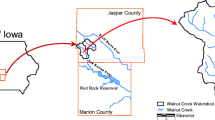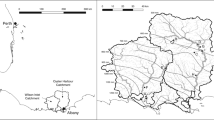Abstract
We investigated the accumulation and influence of bioavailable P (BAP) in sediments of a stream located in an agricultural area of the Lake Mendota watershed in Wisconsin, USA. During hydrologic events, the stream carried high concentrations of suspended sediment (up to 250 mg/l) and BAP (up to 2.5 mg/l). Bed sediments were highly enriched in BAP, as inventories of BAP in the top 10 cm of sediment ranged from 143 to 14,500 μg P/cm2. Space variations in BAP inventories were related to site-specific hydrodynamics and geochemical factors, including iron (Fe; r 2 = 0.71) and aluminum (Al; r 2 = 0.54) concentrations. Most sites behaved as potential sinks for dissolved reactive phosphate during hydrologic events and potential sources during base-flow periods. Through the combination of site-specific factors and geochemical controls, Dorn Creek modifies the amount, timing, and composition of P delivered from the watershed to downstream sites and water bodies.







Similar content being viewed by others
References
APHA (1992) Standard methods for examination of water and wastewater, 18th edn. American Public Health Association, Washington DC
Armstrong DE, Perry JR, Flatness D (1979) Availability of pollutants associated with suspended river sediments, which gain access to the Great Lakes. USEPA Rep. 905.4-79-028. Great Lakes National Program Office, USEPA, Chicago
Bartlett R, James B (1980) Studying dried, stored soil samples—some pitfalls. Soil Sci Soc Am J 44:721–724
Bennett EM, Reed-Anderson T, Houser JN, Gabriel JR, Carpenter SR (1999) A phosphorus budget for the Lake Mendota watershed. Ecosystem 2:69–75. doi:10.1007/s100219900059
Bortleson GC (1968) Chemistry of lake sediment cores. MS Thesis, University of Wisconsin-Madison
Cabot P (2006) Relating sediment and phosphorus movement at multiple scales using fallout cesium-137, phosphorus sorption dynamics and precision conservation technology. PhD Thesis, University of Wisconsin-Madison
Caroco NF, Cole JJ, Likens GE (1993) Sulfate control of phosphorus availability in lakes. Hydrobiology 253:275–280
Chang SC, Jackson ML (1958) Soil phosphorus fractions in some representative soils. J Soil Sci 9:109–119. doi:10.1111/j.1365-2389.1958.tb01903.x
Cline D (1979) Geology and ground-water resources of Dane County, Wisconsin. US Geological Survey Water-Supply Paper 1779-U
Correll DL (1998) The role of phosphorus in the eutrophication of receiving waters: a review. J Environ Qual 27:261–266
Dane JH, Topp GC (eds) (2002) Methods of soil analysis, part 4, physical methods. Book Series Number 5. Soil Science Society of America, Madison
Dorich RA, Nelson DW, Sommers LE (1984) Algal availability of phosphorus in suspended stream sediments of varying particle size. J Environ Qual 13:82–86
Dorich RA, Nelson DW, Sommers LE (1985) Estimating algal available phosphorus in suspended sediments by chemical extraction. J Environ Qual 14:400–405
Fang F, Brezonik PL, Mulla DJ, Hatch LK (2005) Characterization of soil algal bioavailable phosphorus in the Minnesota River basin. Soil Sci Soc Am J 69:1016–1025
Froelich PN (1988) Kinetic control of dissolved phosphate in natural rivers and estuaries: a primer on the phosphate buffer mechanism. Limnol Oceanogr 33:649–668
Gächter R, Müller B (2003) Why the phosphorus retention of lakes does not necessarily depend on the oxygen supply to their sediment surface. Limnol Oceanogr 48:929–933
Haggard BE, Ekka SA, Matlock MD, Chaubey I (2004) Phosphate equilibrium between stream sediments and water: potential effect of chemical amendments. Trans ASAE 47:1113–1118
Hanna M (1989) Biologically available phosphorus: estimation and prediction using an anion-exchange resin. Can J Fish Aquat Sci 46:638–643
Haygarth PM, Condron LM, Heathwaite AL, Turner BL, Harris GP (2005) The phosphorus transfer continuum: linking source to impact with an interdisciplinary and multi-scaled approach. Sci Total Environ 344:5–14. doi:10.1016/j.scitotenv.2005.02.001
Hoffman AR (2008) Bioavailability of sediment phosphorus in geochemically contrasting aquatic systems. PhD Thesis, University of Wisconsin-Madison
Huettl PJ, Wendt RC, Corey RB (1979) Prediction of algal available phosphorus in runoff suspensions. J Environ Qual 8:130–132
Klotz RL (1988) Sediment control of soluble reactive phosphorus in Hoxie Gorge Creek, New York. Can J Fish Aquat Sci 45:2026–2034
Koski-Vähälä J, Hartikainen H (2001) Assessment of the risk of phosphorus loading due to resuspended sediment. J Environ Qual 30:960–966
Lathrop RC, Carpenter SR, Stow CA, Soranno PA, Panuska JC (1998) Phosphorus loading reductions needed to control blue–green algal blooms in Lake Mendota. Can J Fish Aquat Sci 55:1169–1178. doi:10.1139/cjfas-55-5-1169
Lin TH, Ho SB, Houng KH (1991) The use of iron oxide impregnated filter paper for the extraction of available phosphorus from Taiwan soils. Plant Soil 133:219–226. doi:10.1007/BF00009194
Lottig NR, Stanley EH (2007) Benthic sediment influence on dissolved phosphorus concentrations in a headwater stream. Biogeochem 84:297–309. doi:10.1007/s10533-007-9116-0
McDowell RW, Sharpley AN (2002) A comparison of fluvial sediment phosphorus (P) chemistry in relation to location and potential to influence stream P concentrations. Aquat Geochem 7:255–265. doi:10.1023/A:1015274426411
McDowell RW, Wilcock RJ (2004) Particulate phosphorus transport within stream flow of an agricultural catchment. J Environ Qual 33:2111–2121
Meyer JL (1979) The role of sediments and bryophytes in phosphorus dynamics in a headwater stream ecosystem. Limnol Oceanogr 24:365–375
Murdock E (2005) Transport and storage of sediments and solutes in a small agricultural stream, Dane County, Wisconsin. MS Thesis, University of Wisconsin-Madison
Murphy J, Riley JP (1962) A modified single solution method for the determination of phosphate in natural waters. Anal Chim Acta 27:31–36. doi:10.1016/S0003-2670(00)88444-5
Nair PS, Logan TJ, Sharpley AN, Summers LE, Tabatai MA (1984) Interlaboratory comparison of a standardized phosphorus adsorption procedure. J Environ Qual 13:591–595
Reddy KR, Diaz OA, Scinto LJ, Agami M (1995) Phosphorus dynamics in selected wetlands and streams of the Lake Okeechobee Basin. Ecol Eng 5:183–207. doi:10.1016/0925-8574(95)00024-0
Reddy KR, Flaig EG, Graetz DA (1996) Phosphorus storage capacity of upland, wetlands, streams of Lake Okeechobee watershed, Florida. Agric Ecosyst Environ 59:203–216. doi:10.1016/0167-8809(96)01039-0
Reddy KR, Kadlec RH, Flaig EG, Gale PM (1999) Phosphorus retention in streams and wetlands: a review. Crit Rev Environ Sci Technol 29:83–146. doi:10.1080/10643389991259182
Roden EE, Edmonds JW (1997) Phosphate mobilization in iron-rich anaerobic sediments: microbial Fe(III) oxide reduction versus iron-sulfide formation. Arch Hydrobiol 139:347–378
Rogers J (2006) Hydrologic and water quality characteristics of a small wetland—Upper Dorn Creek Wetland, Wisconsin. MS Thesis, University of Wisconsin-Madison
Schindler DE (2006) Recent advances in the understanding and management of eutrophication. Limnol Oceanogr 51:356–363
Sharpley AN (1993) An innovative approach to estimate bioavailable phosphorus in agricultural runoff using iron oxide-impregnated paper. J Environ Qual 22:597–601
Sharpley AN, Troeger WW, Smith SJ (1991) The measurement of bioavailable phosphorus in agricultural runoff. J Environ Qual 20:235–238
Sharpley AN, Robinson JS, Smith SJ (1995) Bioavailable phosphorus dynamics in agricultural soils and effects on water quality. Geoderma 67:1–15. doi:10.1016/0016-7061(94)00027-8
Smith DR, Warnemuende EA, Haggard BE, Huang C (2006) Changes in sediment-water column phosphorus interactions following sediment disturbance. Ecol Eng 27:71–78. doi:10.1016/j.ecoleng.2005.10.013
Stone M, Murdock A (1989) The effect of particle size, chemistry, and mineralogy of river sediments on phosphate adsorption. Environ Technol Lett 10:501–510
Syers JK, Harris RF, Armstrong DE (1973) Phosphate chemistry in lake sediments. J Environ Qual 2:1–14
Taylor AW, Kunishi H (1971) Phosphate equilibria on stream sediment and soil in a watershed draining an agricultural region. J Agric Food Chem 19:827–831. doi:10.1021/jf60177a061
Tiessen H (ed) (1995) Phosphorus in the global environment. SCOPE 54. Wiley, England
Turner BL, Haygarth PM (2001) Phosphorus solubilization in rewetted soils. Nature 411:258–258. doi:10.1038/35077146
Williams JDH, Syers JK, Harris RF, Armstrong DE (1971a) Fractionation of inorganic phosphate in calcareous lake sediments. Soil Sci Soc Am Proc 15:250–255
Williams JDH, Syers JK, Shukla SS, Armstrong DE, Harris RF (1971b) Levels of inorganic and total phosphorus in lake sediments as related to other sediment parameters. Environ Sci Technol 5:1113–1120. doi:10.1021/es60058a001
Williams JDH, Jaquet JM, Thomas RL (1976a) Forms of phosphorus in the surficial sediments of Lake Erie. J Fish Res Board Can 33:413–429
Williams JDH, Murphy TP, Mayer T (1976b) Rates of accumulation of phosphorus forms in Lake Erie sediments. J Fish Res Board Can 33:430–439
Williams JDH, Shear H, Thomas RL (1980) Availability to Scenedesmus quadricauda of different forms of phosphorus in sedimentary materials from the Great Lakes. Limnol Oceanogr 25:1–11
Wood PJ, Armitage PD (1997) Biological effects of fine sediment in the lotic environment. Environ Manage 21:203–217. doi:10.1007/s002679900019
Zhang JZ, Huang XL (2007) Relative importance of solid-phase phosphorus and iron on the sorption behavior of sediments. Environ Sci Technol 41:2789–2795. doi:10.1021/es061836q
Acknowledgments
This research was supported in part by EPA Nutrient Science STAR Grant R-830669. The authors would like to thank Pat Anderson and Mitch Asch for sample analysis, and Michelle Richardson for assisting with preparation of the watershed map. We also thank four anonymous reviewers for their constructive comments and helpful corrections to this manuscript.
Author information
Authors and Affiliations
Corresponding author
Rights and permissions
About this article
Cite this article
Hoffman, A.R., Armstrong, D.E., Lathrop, R.C. et al. Characteristics and Influence of Phosphorus Accumulated in the Bed Sediments of a Stream Located in an Agricultural Watershed. Aquat Geochem 15, 371–389 (2009). https://doi.org/10.1007/s10498-008-9043-2
Received:
Accepted:
Published:
Issue Date:
DOI: https://doi.org/10.1007/s10498-008-9043-2




